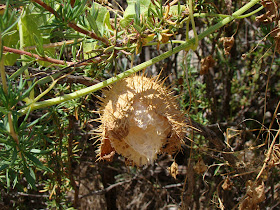Borage
Borage is a rare and beautiful plant cultivated for its medicinal properties. It has bright blue flowers reminiscent of flowers in the nightshade family, only bigger. Yet, borage belongs to Borage family (Boraginaceae).
Borage flower close-up
Borage stems are hairy. The flowers are usually bright blue. The plant is easily recognized by its general appearance.
Among the medicinal uses, borage oil is quite famous (extracted from seeds, a good source of Omega-6 acids). The plant is also used to treat respiratory maladies. Borage is reputed to be edible and is supposed to taste like cucumber. I tried it and it does have cucumber flavor but very, very faint. The texture is not particularly palatable as stems and leaves are hairy. Borage is also supposed "to gladden the heart" and to achieve that one must put crushed pieces of flowers into wine and let seep a little bit. I tried that too and I found the taste rather pleasant. And, yes, it did gladden the heart.














